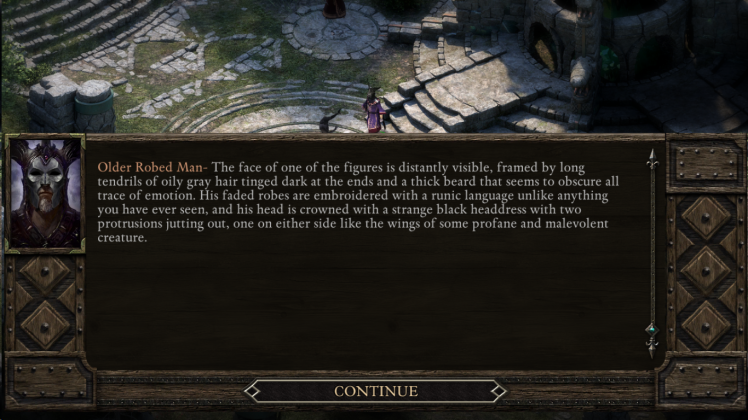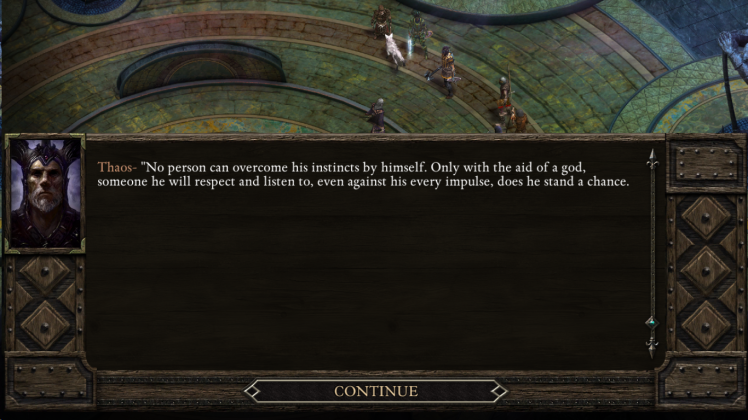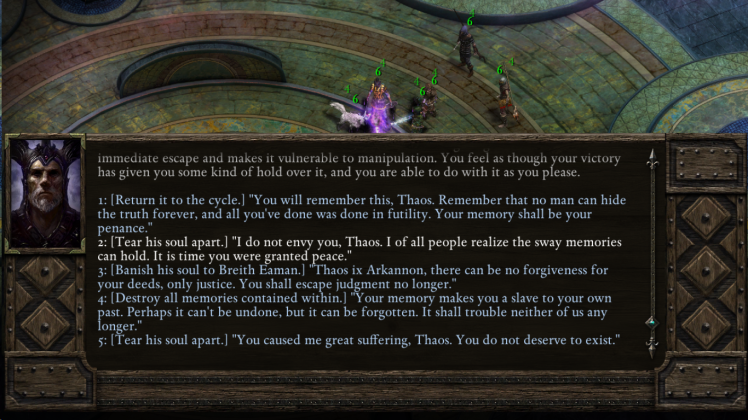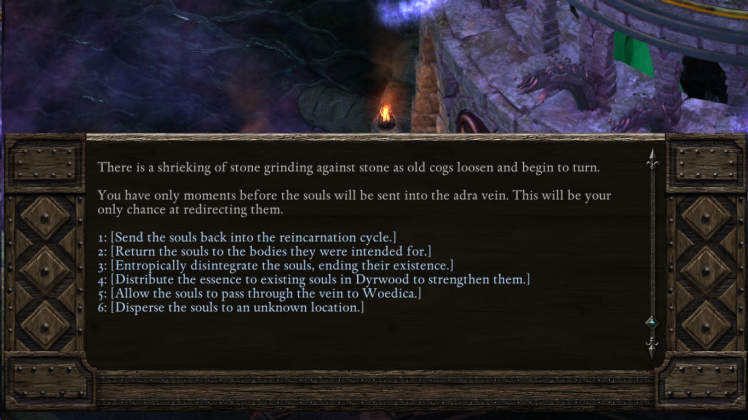I recently finished Obsidian’s Pillars of Eternity, their Kickstarter-funded videogame that deliberately hearkens back to the 90s and Interplay’s computer RPG classics, Planescape: Torment and Baldur’s Gate, and I think I have three or four posts’ worth of material I’d like to talk about from that experience. Later, I’ll discuss the game’s gods, the design and writing of the NPC companions, and what I didn’t like about the game. Today, I’ll discuss the game’s ending, in the context of Eugene Thacker’s writings about life in Starry Speculative Corpse. As I hope was implied by saying that I’m going to discuss the game’s ending, there will be spoilers.
Part I: Pillars of Eternity and a few good souls
First, let’s talk plot. This is going to involve heavy consultation of the game’s wiki, as I can never remember any names in a work of fiction as soon as I cease being engaged with it. In the 90s, I filled up my head with the name of Marvel characters, and lost the ability to retain any others. It’s a shame, but at least I’ll never forget the likes of Joseph, Adam X, and Maggott.
In the game, you can choose your character’s race, gender, and profession, which occasionally affect more than just combat, but in general you play a blank slate. You have emigrated to Dyrwood at the promises of a new life, but things immediately go rather sour: first, Dyrwood itself is suffering from the Hollowborn Plague–children are being born without souls, and living their entire lives in a vegetative state.The cause is unknown, but a leading theory is that it’s the fault of animancers, scientists/wizards who study and perform magic on souls–there’s a lot of them in Dyrwood, as its relatively wild state means there’s less regulation than in some countries. But regardless of what’s causing it, it’s happening, and no one seems to know how to stop it.
But before you can even become aware of any of that, you’re caught in a storm that kills the rest of your caravan, and witness a strange magical rite performed by a man you’ll eventually learn is named Thaos. There’s an accident, and you’re granted the powers of a Watcher–someone who can perceive and affect the souls of others. It also turned you into an awakened soul, which means that you have visions of your past life, which is not so good, as those visions may eventually drive you insane. So your starting marching orders–once you’ve figured out what a Watcher is–is to track down Thaos and get him to reverse the process.

That’s more or less the state of things at the end of Act I. Throughout the game, you get more visions of the past, until you can more or less piece the whole thing together. Thaos, in the long past, was the leader of a religious Inquisition bent on destroying a heretic named Iovara and her followers. Your past self was caught between them, as a loyal member of Thaos’ Inquisition, but also someone close to Iovara. Ultimately, you (without any choice in the matter by the player) betray Iovara, and she dies, tortured but unrepentant.
Now, though, Thaos is running a different scam, in collusion with Woedica, goddess of justice, vengeance, and oaths. Skipping over a lot, the endgame plot revolves around two revelations. First is what led Iovara to rebel; more on that next post. Second is Thaos’ scheme. He’s the one who caused the Hollowborn Plague (remember that, from four paragraphs ago?), in part to whip up mistrust regarding the animancers, but also so that he can inject all that unborn children soul goodness straight into Woedica to make her an ubergoddess. (As a quick aside, I kind of liked that plot development– it reminded me a lot of the way Neil Gaiman’s American Gods shakes out. And it sets the stakes here–not the end of the world, but a reckoning for a pair of thieves.) Naturally, it’d be a pretty poor character arc on your part if he got away with this, so there’s the traditional end boss fight.

The fight itself isn’t two bad–it’s Thaos and two giant animated statues. The only real catch is that as Thaos’ health goes down, he moves his soul into the statues, which makes his body invincible. So until I tweaked onto that (or, cough, read it in a wiki) I had diverted a third of my forces to attacking the invulnerable character. Once that was straightened out, he went down pretty quickly.
You’re immediately given a choice on what to do with Thaos, which is an interesting set of options:

Here, Pillars of Eternity hearkens back to its predecessors, which also gave the player a variety of choices to make in the finales, choices that spoke most to what sort of character the player envisions she’s playing. Particularly interesting to me is that options 2 and 5 are the same result, but allow you to choose different motivations. I went with 4, by the way. I was roleplaying as a pretty white hat character. I think a contributing factor is that, as far as RPG villains go, Thaos tended not to act directly on us. Yes, he harmed someone close to the player, but that was another life entirely, and yes, he caused the hollowing and a civil war (I skipped that part), but for the most part, he’s kept pretty far from the PC for most of the game. I think that distance made it easier for me to skip over the more vengeful options.
Another way of looking at it, though, is that this choice is sort of a practice run for the game’s actual final choice. If those stolen souls aren’t going to Woedica, where are they going to go? The choice is yours: So. You can let the souls re-enter the cycle of birth and death, which will end the Hollowing, but leave all the soulless children empty husks. You can send the souls back into the children–but that will absolutely destroy the parents who made the very hard choice of ending their soulless children. You can remove the souls from the cycle altogether, thus speeding up the gradual entropy of existence–an odd choice, but hey, it’s ok for things to end some day. You can take the souls and use them to empower the people of Dyrwood–strengthening the people who remain there. Just before you get the choices, Woedica bids you to take Theos’ place as her favorite, and just give her the souls as originally planned–you can, if you want. (It’s clearly the “evil” choice, but you can.) And finally, you can let the souls go where they may,whatever that may entail–it’s the randomizer option, basically. Regardless of which choice you make, the Hollowborn Plague ends, so the real choice is, again, what ending you feel best suits your character, as you’ve been playing it.
So. You can let the souls re-enter the cycle of birth and death, which will end the Hollowing, but leave all the soulless children empty husks. You can send the souls back into the children–but that will absolutely destroy the parents who made the very hard choice of ending their soulless children. You can remove the souls from the cycle altogether, thus speeding up the gradual entropy of existence–an odd choice, but hey, it’s ok for things to end some day. You can take the souls and use them to empower the people of Dyrwood–strengthening the people who remain there. Just before you get the choices, Woedica bids you to take Theos’ place as her favorite, and just give her the souls as originally planned–you can, if you want. (It’s clearly the “evil” choice, but you can.) And finally, you can let the souls go where they may,whatever that may entail–it’s the randomizer option, basically. Regardless of which choice you make, the Hollowborn Plague ends, so the real choice is, again, what ending you feel best suits your character, as you’ve been playing it.
Actually, it’s not quite that simple–each option is one that is favored by one of the main deities of the gameworld, and, in fact, to get the final dungeon, you have to promise one of four gods that you’ll definitely take one of the first four options. But more on that next post. For now, let’s take a step back. This final choice is about choosing what happens to a set of souls, to lifeforce. But what is life?
Part II: Philosophy, Lovecraft-style
This, finally, is where the theory part of the post comes in. Eugene Thacker’s three volume Horror of Philosophy series is concerned with thinking through the things that are, for one reason or another, beyond our ability to grasp entirely, often because they’re things we can’t experience. We can’t know first hand, for example, exactly what an earth without humans on it would look like.
Volume 2 is specifically looking at these concepts in terms of how philosophers throughout history have handled these issues. The first chapter offers a sample with a trifecta of well-known philosophers: Descartes’ theory of being is riddled with all the places where our firsthand knowledge fails, and uncertainty about the existence around us rules; Kant’s depression, Thacker argues, may stem from the realization that mastery of reason may not coincide with the self-mastery of ourselves as human beings, that rational thinking may not always be in the favor of humanity; Nietzsche’s frequently pessimistic writings are often openly contemptuous of humanity’s self-aggrandizing. Later chapters look into specific issues: darkness and blackness through early Christian mystics; nothingness through the Japanese buddhist Kyoto school; and life itself.
In comparison to emptiness and darkness, life might seem like a strange choice for Thacker’s study. But Thacker argues that our typical conception of life is always in terms of abundance–life is “generative, proliferating, productive and reproductive.” It’s thought of as affirmative, and as with many affirmations in western philosophy, we treat its opposing negation as something subsumed in it–in this case, it’s a truism that death is a part of life, and we have concepts like the circle of life (thanks, Lion King) to reinforce that subsuming. To bring it back to Pillars of Eternity, life as affirmation can be thought of as the option to return the souls to cycle. But what happens if we treat life as if constituted not by affirmation but negation?
I imagine there’s got to be something of an answer to this question in Thacker’s earlier book, After Life. But in the text at hand, he speaks to the issue as well. Going as far back to Aristotle, life is often thought of as a general life-force, Life with a capital L, whereas every living creature manifests some facet of Life, but not its entirety. So how do we know anything about Life if it isn’t the living experience of any one being or collection of beings, and isn’t reducible just to those beings either? To quote Thacker:
In short, it would seem that the life common to all living beings is ultimately enigmatic and inaccessible to thought, since any given instance of the living (as subject or object) is not life-in-itself, but only one manifestation of life. It seems that there is some residual zone of inaccessibility that at once guarantees that there is a life-in-itself for all instances of the living, while also remaining, in itself, utterly obscure.
Thacker is arguing that Life, something we take for granted as being integral to human beings and, you know, living, is in some sense beyond our ability to grasp in its entirety. Life is everywhere, but inaccessible in full.
That’s the typical view of Life, what Thacker calls the generosity of life. He splits it into variations: life as genesis, where Life is the wellspring from which living things flow. Life is givenness, where Life is the process continually given for living things to exist (again, the cycle perspective). The generosity form then allows us to conceive of ascensionism, raising Life up to a “metaphysical principle,” which allows us to make assumptions like the world itself being alive, or life being all that comprises the world. The problem Thacker sees with all this affirmative life, though, is that leads us to romanticizing Life as a force of good in itself, and can be totalized as such as a force humanity can harness and apply when necessary.
This criticism leads back to Thacker’s original question. If Life as affirmation is limiting, what can we do with Life as negation? For this, he turns to German philosopher Arthur Schopenhauer. I’m glossing over quite a bit, but Schopenhauer depicts life as a sort of by product or effect of the general inaccessibleness of everything:
As the will is in the thing-in-itself, the inner content, the essence of the world, but life, the visible world, the phenomenon, is only the mirror of the will, this world will accompany the will as inseparably as a body is accompanied by its shadow; and if will exists, then life, the world, will exist. Therefore life is certain to the will-to-live…
To Thacker, this principle hinges on three concepts. First, to Schopenhauer, the human body is the nexus of Representation and Will–where representation refers to everything we perceive, and Will to, well, everything else. Life, he (Schopenhauer) argues, is not so much a part of experience, but of Will. Further, Will is driven by negation–it “asserts itself through contradictions, oppositions, subtractions, and its limit is the self-negation of life, through life.” Because the Will by definition lies outside of our ability to reason it, we can only understand what it isn’t. Thus, Life as regards Will, the Will-to-Life, is that aspect of life which is defined by an indifference to humanity. Thacker notes that this all leads Schopenhauer to what Thacker calls a cosmic pessimism, where “the whole world, like man himself, is through and through will and through and through representation, and beyond this there is nothing.”
Thacker build from this point to his concept of cosmic pessimism, but I think that’s far enough to go for our purposes. I wouldn’t say Thacker’s philosophical musing explain Pillars of Eternity. I’d lean a bit more towards saying that Pillars of Eternity explains some of Thacker’s musings. For the moment, though, I want to consider how the two works play off each other.
Part III: Putting the Pieces Together
Let’s revisit Thaos. 
As this screenshot suggests, Thaos would find Schopenhauer’s and Thacker’s philosophies repulsive. The idea that there may not be any meaning to life, that the world and existence and life are all indifferent to the individual human is abhorrent to him on every level. He maintains that without a firm affirmation that our existence has a purpose, humanity would destroy itself. (Ok, humanity is the wrong term, because there’s also elves, dwarves, and various other species.)To him, religion is necessary because it grants man a purpose, and the lengths to which he goes to in order to maintain that purpose is something we can talk about next post.
Moving back to the main topic, Pillars of Eternity is taking some very interesting stances in regards to Life, which match up only in parts to the forms Thacker describes. First, Life as in “life force” isn’t some vague, ethereal concept for the people of Eora like it is for us–they know the soul exists, because Watchers can see them, and animancers can magick them. They know the cycle exists, because Watchers can tap into past lives. Although perhaps it’s fairer to say that the animancers and Watchers know that these things exist–everyone else has to take their word for it, which leads to many different cultural substantiations of trust and mistrust. And on that level, the game is useful, as it offers a more in-depth look at what happens when the ideas Thacker is discussing are brought to the forefront of every day life. (small l, not Life). And even in fictional form, that’s nice to see; one of the flaws I think in discussing philosophy regarding the inconceivable is that it often ignores how these discussions affect people.
And yet, Eora is more complicated than us, as well. The mind-body problem isn’t some abstract division for them. Thanks to the Hollowborn Plague, the people of Dyrwood have received a front row lesson on how soul and body can be divided, and the tragedy of what happens when body exists without soul. But that raises further questions–if the soul and body can be split, where is the individual life? The soulless children are alive, in the sense that they breathe, fall asleep, can be exhorted into eating, and so forth. Is that enough? Is life and soul the same thing, or is there some significant difference?
Let’s revisit those soul choices. To spare you from constant scrolling, here they are again:

First, all of these options go against the life as negation view in one significant way–it’s the player’s choice what happens. That is, human agency through the player is front and center as the force that moves the game world. In general, most, if not all, videogames spend a lot of rhetorical capital in cementing that notion, that the player character is the most important being in the gameworld, for at least as long as the game at hand goes on. That positioning radically changes Thacker’s philosophies, from an in-game perspective at least. (Sidenote 1: for an example of a story that hinges on this concept, think Hitchhiker’s Guide to the Galaxy, and Zaphod Beeblebrox, who survives the total perspective vortex, but only because the universe he was in at the time was designed expressly for him) (Sidenote 2: videogames are a useful variant for Thacker’s philosophy of horror, I think–on the one hand, they’re designed for the player. On the other, there are always going to be significant aspects of the game that are kept from the player’s purview. Videogames cater to the illusion of control more to control itself.)
The possible exception is the final choice, to allow the souls to disperse where they may. Even then, there’s complications–it’s still your choice to put that roulette wheel in motion, and, as with all the choices, it’s presented as one favored by a particular god–Wael, god of dreams, secrets, mysteries, and revelations.

The imagery Wael offers is that the souls will dispersed ala Johnny Appleseed–random scatterings that are placed where they land, and may thus bear new fruits. On the one hand, it’s the only option that breaks away from human determination, but on the other, it’s still catering to the notion of life as genesis, that the souls will create these new mysteries. That’s significant, I think. Of the options Thacker outlines, it doesn’t have to be either/or; there can be a little bit of life as generative force, AND life as utterly beyond human grasp.
Options 1 and 2–return the souls to the cycle, or return them to the soulless children still, uh, alive (there’s that term slippage again) are perhaps illustrative of the life as giveness concept, where Life is that which is continually given to living things–the difference here is whether you grant them to the already living, or those yet to be born. Option 2, I should note, is the one I picked, and to be honest, these two were the only two I really considered. Going utterly against any of Thacker’s precepts, I made my decision entirely based on humans already living and who could have lived, deciding that it was only “fair” that they be given back the chance that was taken from them. The only thing that made me uncertain and pushed me towards option 1 was that 2 was going to cause incredible amounts of suffering to the parents who didn’t keep their soulless children, and that the children themselves were going to have very rough lives–would they be infants in bodies a decade old? Would that make things worse? And there’s also some idea inherent in my choice that possessing life is like possessing property–do the living have a “right” to own the lives that Thaos took from them, and does my choice imply that I believe that? (Well, no, I don’t think I do believe that, but it’s a question that arises.)
Options 4 and 5–to give the souls to Woedica, or use them to strengthen the souls already in Dyrwood) complicate what life means in Eora even further. The notion of a cycle, and that people can access memories from their past lives, suggests that souls are indivisible, and unique. In particular, it suggests a direct connection between life, in its individual substantiation, and Life, where Life is more or less the composite of all lives within the soul cycle. But options 4 and 5 belie that notion. If you can take the souls that have been torn out through the Hollowborn Plague and just invest them in another being… well, what happens to that being? Does it become more powerful, ala Jet Li’s the One? Is having a bunch of souls equivalent to being really healthy, then? Is the person infused a new person entirely? Do they carry the memories of the other souls’ past lives, or are the souls dispersed among the various Dyrwood folk?
Well, we don’t have to leave these as rhetorical questions, not entirely, anyway. The game’s endings display text that briefly corresponds to the endings the player chooses. Choosing to give the souls to Dyrwood makes the inhabitants more generally resistant and willing to carry on–which carries its own assumptions about the nature of life, depicting it as a rather literal version of Schopenhauer’s Will-to-Life. Choosing to give them to Woedica doesn’t appear to have any consequence at all beyond fixing her statue, though there’s a hint of something more ominous to come.
Finally, we have option three, to extinguish the souls. Arguably, this option is both the farthest and the closest to what Thacker calls a negation of life. It’s the farthest, because it’s expressed in terms of a loss; the souls are a net gain on the balance book of the universe, and thus their dispersal is a loss and the advancement of entropy. Further, in the description of the game endings, this extinguishing is framed as a peaceful rest, which contains its own life-affirming aspects. But at the same time, to choose it as your option, to act as if that’s the best course of action, is to act against the principle that life in and of itself is the ultimate good. It could have been very easy to cast this as an “evil” option, but the game doesn’t impose that kind of judgment on it.
Thacker’s discussion on Life doesn’t “solve” Pillars of Eternity or vice versa. Instead, I think they both illustrate how complicated our concept(s) of life can be, that it’s possible to conceive of ways of approaching life beyond black and white abundance and absence. And that we have avenues to do this in both philosophy books and videogames is pretty great, I think.

Well, and here I was thinking I was the only person who played Pillars of Eternity and read Eugene Thacker’s books.
LikeLike
We are a select bunch.
Honestly, I find Thacker really useful as a go-to source not just for these purposes, but for an approach to horror that goes in a different direction than Noel Carroll’s monster-centric theories.
LikeLike